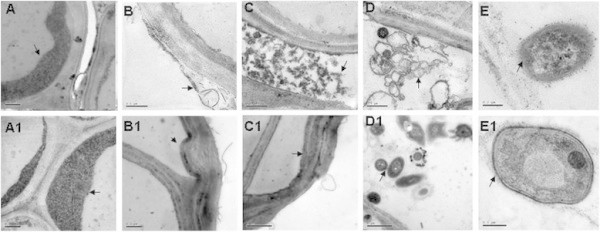Figure 6.

Root ultrastructure of Nipponbare-2x and Nipponbare-4x under salt stress (Bar in E = 0.2 μm; others bars = 0.5 μm). (A) The epidermis cells with abundant cytoplasm (arrow) in the diploid without NaCl treatment. (A1) The epidermis cells in tetraploid rice were similar to the diploid under normal conditions. Arrow indicates abundant cytoplasm. (B) After NaCl treatment for 3 days the cell wall of the epidermis cells became loose (arrow). (B1) The cell wall of epidermis cells in Nipponbare-4x became thicker and formed a barrier around the cells (arrow). (C) Floccules (arrow) were discovered between the epidermis cells in Nipponbare-2x. (C1) The epidermis cells were normal in Nipponbare-4x, and the arrow shows normal abundant cytoplasm. (D) Membrane organelles were indicative of evident transfiguration (arrow) in the pericycle cells of Nipponbare-2x. (D1) Pericycle cells maintained a normal shape surrounded by cytoplasm (arrow) in Nipponbare-4x. (E) The nuclei with an abnormal shape, whereby floccule nuclear cytoplasm was observed in the pericycle cells of Nipponbare-2x (arrow). (E1) Nuclei with intact membrane (arrow) and dispersed chromatins were observed in pericycle cells of Nipponbare-4x.
